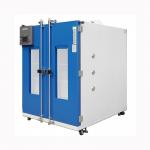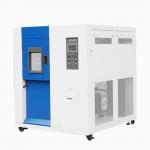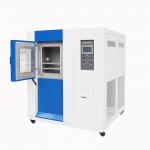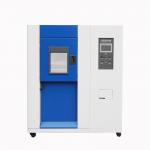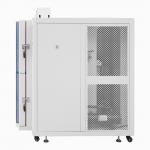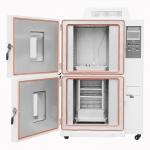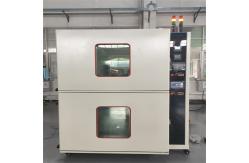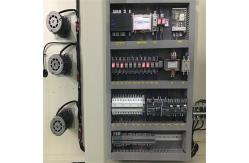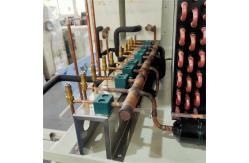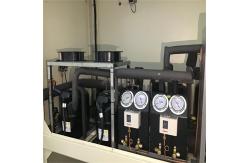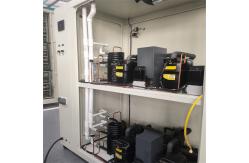In the fast-paced and highly competitive world of modern
manufacturing and research, the ability to subject products and
materials to precise and extreme temperature conditions is a
cornerstone of success. The customized Two-Zone High-Low
Temperature Test Chamber emerges as a state-of-the-art solution,
engineered to meet the diverse and demanding needs of industries
ranging from electronics and automotive to aerospace and
pharmaceuticals. This advanced test chamber is designed to create two distinct
temperature zones, each capable of replicating a wide spectrum of
high and low temperature environments. It serves as an
indispensable tool for industries seeking to evaluate the
performance, durability, and reliability of their products and
components. By simulating the harsh temperature gradients and
fluctuations that occur in real-world applications, manufacturers
and researchers can gain invaluable insights, optimize product
designs, and ensure compliance with industry standards. - Robust and Insulated Chamber Construction
- The two-zone chamber is built with a heavy-duty steel frame that
provides exceptional rigidity and stability. The frame is coated
with a corrosion-resistant finish, ensuring a long service life
even in the most challenging testing conditions. The chamber walls
are made of high-quality insulation materials, which minimize heat
transfer between the zones and maintain precise temperature levels.
The insulation is carefully engineered to withstand rapid
temperature cycling and prevent any external factors from
interfering with the internal test environment. The chamber is
equipped with hermetic door seals for each zone, guaranteeing a
leak-free enclosure and consistent test conditions.
- Precision Temperature Control System for Two Zones
- The integrated control system is a marvel of technological
sophistication. It can maintain a wide temperature range in each
zone, from -70°C to +180°C, with an accuracy of ±0.5°C. The system
utilizes advanced refrigeration units, electric heaters, and PID
controllers. Temperature sensors are strategically placed within
each zone to provide real-time feedback, enabling the control
system to make instantaneous and highly accurate adjustments. This
allows for the creation of independent temperature profiles in each
zone, simulating a variety of real-world scenarios such as the
temperature differential between the interior and exterior of an
electronic device or the hot and cold zones in an industrial
process.
- Intuitive Control and Data Acquisition Interface
- The equipment is equipped with an intuitive control panel and a
comprehensive data acquisition system. The control panel allows
operators to easily set and adjust the temperature parameters, test
durations, and cycle repetitions for each zone. It provides
real-time display of the current temperature in each zone, as well
as any alarms or warnings. The data acquisition system records all
relevant test data, including temperature histories, any changes in
the physical properties of the test samples, and system performance
metrics. The data can be stored in a built-in memory or exported to
external storage devices for further analysis. The system also has
the ability to generate detailed test reports in various formats,
such as PDF or Excel, facilitating easy documentation and sharing
of test results.
- Versatile Sample Fixturing and Placement
- The chamber is designed with a flexible interior layout to
accommodate different sizes and shapes of test samples in each
zone. It can be equipped with adjustable shelves, racks, and
mounting fixtures, allowing for optimal sample positioning and
organization. The interior surfaces are made of non-corrosive and
non-reactive materials to prevent any contamination or interaction
with the test samples. Additionally, the chamber can be fitted with
cable ports, access doors, and viewing windows to facilitate
testing, monitoring, and connection of external equipment or
sensors.
- Enhanced Safety and Protection Mechanisms
- Safety is a top priority in the design of this chamber. It is
equipped with a comprehensive suite of safety features, including
emergency stop buttons strategically located for immediate shutdown
in case of any anomalies. The chamber is safeguarded against
over-temperature, over-current, and over-pressure conditions, with
built-in safety circuits that automatically cut off power when
necessary. Additionally, it features advanced refrigerant leak
detection and a highly efficient ventilation system to ensure the
removal of any potentially harmful gases. The door interlock system
for each zone prevents accidental opening during testing, further
enhancing operator safety and test integrity.
- Maximum Temperature Swing in Each Zone
- With a temperature range spanning from -70°C to +180°C in each
zone, the chamber can achieve a maximum temperature swing of 250°C.
This wide temperature spectrum allows for the simulation of the
most extreme environmental conditions, from the frigid cold of
cryogenic storage to the searing heat of industrial ovens. For
example, in the electronics industry, components may need to
withstand significant temperature differentials during operation or
storage, and this chamber can accurately replicate such conditions
to assess their durability and performance.
- Temperature Change Rate in Each Zone
- The chamber can achieve a temperature change rate of up to 15°C per
minute in each zone. This rapid rate of change is crucial for
simulating real-world temperature fluctuations, such as those
experienced during rapid thermal cycling in manufacturing processes
or during the startup and shutdown of equipment. In the automotive
industry, for instance, engine components and electronic control
units may be subjected to sudden temperature changes, and this
chamber enables manufacturers to evaluate their ability to
withstand such stress without failure.
- Testing Volume and Payload Capacity per Zone
- The chamber offers a customizable testing volume per zone, with
options ranging from 0.3 m³ to 3 m³. The payload capacity can be
adjusted according to the size and weight of the test samples, with
a maximum capacity of up to 300 kg per zone. This flexibility
allows for the testing of a wide range of products, from small
electronic components to larger industrial equipment or prototypes.
For example, in the pharmaceutical industry, it can be used to test
the stability of drug formulations or the performance of packaging
materials under different temperature conditions.
- Temperature Uniformity within Zones
- The chamber ensures excellent temperature uniformity within each
zone. The temperature variation within a zone is typically within
±1°C. This level of uniformity is essential for obtaining accurate
and reliable test results, as it guarantees that all parts of the
test sample are exposed to the same temperature conditions. In
applications where precise temperature control is critical, such as
in the testing of sensitive electronic components or high-precision
optical devices, this feature is of utmost importance.
- Dwell Time Accuracy in Temperature Cycles
- The chamber can maintain the specified dwell times at different
temperature levels with an accuracy of ±1 minute. Dwell time is an
important parameter in temperature cycling test
|
